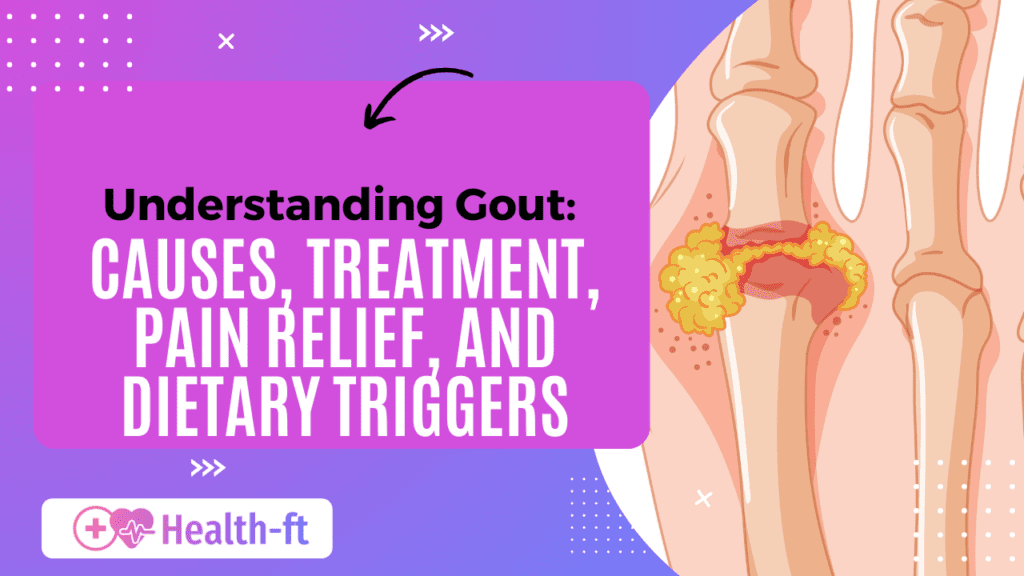Understanding Gout: Causes, Treatment, Pain Relief, and Dietary Triggers
G
In this article, we’ll look at what gout is, what’s wrong with it, how it can be cured, how the attack can be reduced in the short term, and what one should not eat because it leads to gout, so that the reader has a complete picture of gout. We will also cover some of the questions often asked to give readers further understanding of the condition.
What Causes Gout?
The disease is said to erupt from too high concentrations of uric acid in the bloodstream, usually termed hyperuricemia. Uric acid is the end product of the metabolism of purines, which are found in foods of animal origin and some beverages. These uncomfortable deposits result from high uric acid levels which crystallize in the affected joints. Several factors contribute to the development of gout. Major gout causes are given below:
-
Genetic Predisposition
Your DNA also helps to bring out your chances of getting gout. There are also certain risks factors that predispose you to gout; they include: hereditary factors that runs in your family.
-
Dietary Factors
Purines which are found in red meat, organ meats, liver, kidneys and seafood raise uric acid levels and are well documented in causing gout. Other substances that raise uric acid levels include alcohol- beer, fructose which is usually found in most beverages.
-
Obesity
Obesity leads to increased blood concentrations of uric acid and a decreased ability of the kidneys to clear it. Together, these factors can dangerously increase your chances of getting gout.
-
Medical Conditions
Some other diseases like hypertension, kidney ailments, and diabetes, any have an effect on the body’s functionality to manage and eliminate uric acid effectively. Also is the fact that medications such as diuretics and aspirin can cause uric acid levels to rise and therefore cause gout attacks.
-
Dehydration
Normal uric acid levels need to be maintained and this requires proper and healthy intake of fluids to get correct body healthy. Prolonged lack of water also affects the abilities of the kidneys to flush out uric acid from the body and therefore the acid will accumulate in the body.
-
Age and Gender
The gout is more common in the male gender than in the female gender, and is prominent from the age of thirty to fifty years. Female subjects have relatively lower serum uric acid concentration and begin to rise toward male range after the menopausal period.
-
Trauma or Surgery
Surgery or an injury to the body may cause gout attacks because of metabolic changes that ensue or because of immobility that will influence the amount of uric acid in the body.
Treatment Options for Gout
Gout is best handled with medication and some changes in the patient’s lifestyle. A gout treatment does not exist, but these medicines may manage the symptoms, prevent an attack and avoid joint complications.
Medications
- Nonsteroidal Anti-Inflammatory Drugs (NSAIDs):
Non-prescription drugs, which include ibuprofen and naproxen, may be used to decrease inflammation and ease pain during a gout attack. There are also prescribed NSAIDs for cases of more intensity than that of common asymptomatic chiropractic patients.
- Colchicine:
It is usually used to treat gout in order to help manage pain and inflammation, especially if there is no success from using NSAIDs. Colchicine prevents the formation of more crystals of uric acid by inhibiting the movement of them toward the joints.
- Corticosteroids:
In some instances, your doctor can give medicines such as prednisone to bring down the level of inflammation and pain very fast. They can be administered orally or administered in the form of an injection right into the joint area.
- Uric Acid-Lowering Medications:
If you have chronic gout, drugs such as allopurinol and febuxostat can be used, as they decrease blood levels of uric acid. These drugs are usually prescribed in those patients experiencing frequent gout flares.
Lifestyle Modifications
- Weight Management:
Weight loss is an effective way likely to help reduce uric acid levels and the likelihood of developing gout. It is necessary to eat well and exercise.
- Hydration Problem:
Man gets more involved with rubbing and manipulation in the joint region during the early morning trekking and therefore exposes the affected joint to more dangers.
-
Solution:
This is due to the fact that adequate intake of water washes the kidneys and thereby removes excess uric acid hindering the formation of uric acid crystals in joints.
- Limiting Alcohol and Sugary Drinks:
Specifically, being a beer drinker, one should avoid taking beers and also reduced the intake of sugars to help minimize levels of uric acid.
Alternative Therapies
Some people get comfort through so called complementary and alternative therapies, however these must be used together with traditional medicine. Popular options include:
- Acupuncture:
Using acupuncture is said to ease pain and inflammation in conditions and it can help gout patients at least to an extent.
- Herbal Supplements:
Some supplements such as Cherry extract, turmeric and ginger commonly used in foods has been noted to have some anti-inflammatory benefits that could assist in the control of gout. Heat should always be used in consultation with a doctor especially for those taking medication because of possible interaction with the supplement.
Immediate Gout Pain Relief
The pain may be terrible during a gout attack, and that is why it is vital to know how to ease it as soon as possible. Here are some methods for quick gout treatment:
-
Rest and Elevation
Also, the patient should avoid applying pressure and pressure on the pain section of the joint and should try to elevating it in case it is affected. Do not put pressure on the joint whenever possible until such time there is a reduction in the pain.
-
Ice Therapy
Numb and reduced swelling can be achieved by applying ice at the site affected for 20-30 minutes every few hours. Make sure that the injured part is covered with lettuce then followed by a towel to avoid frostbite on the ice.
-
Stay Hydrated
Staying well hydrated rids the body of uric acid profusion and can lessen the inflammation’s frequency and degree required to trigger gout pain. Try and consume not less than 8-10 glasses of water per day.
Paracetamol and aspirin: above the counter painkillers
For a quick fix of your pain relief, you can take over-the-counter drugs such as ibuprofen (Advil) or naproxen (Aleve). Do not take aspirin because it can lead to levels of uric acid that lead to gout.
-
Avoid Trigger Foods
This is so because during an attack foods that should be avoided include; red meat, organ meats, shellfish, and alcohol. Some food products cause the crystallization of uric acid and the pain persists from hours to days.
Foods That Cause Gout
Diet has a very central part in the management of gout. Some foods contain purine and these are converted into uric acid in the body, therefore people suffering from gout should avoid foods containing purine. To minimize gout attacks, it’s important to avoid or limit these foods:
-
Red Meat and Organ Meats
Therefore, sources of purines include foods like beef, lamb, pork, and every other product that is considered as red meat. In this respect, organs like liver, kidneys, and heart contain much higher amounts of purines and should therefore not betriggert. Equal in regard to purine-containing foods should future diabetics avoid are meat products especially organ meats.
-
Seafood
Over 50 percent the reported samples contain purines, and these include anchovies, sardines, mussels, and scallops can precipitate gout attack. Other fish which include the likes of salmon and tuna should be taken in moderation.
- Alcohol
Beer is specially bad for gout patient because it contains a lot of purines. Ether and wine are also known to increase uric acid levels, so one should avoid alcohol.
-
Sugary Foods and Drinks
Several foods and drinks are high in sugar and can boost the levels of fructose, which raises the levels of uric acid. Reducing consumption of refined carbohydrates – sweets and sodas for instance, will assist reduce the frequency of gout episodes.
-
Processed Foods
Quick and ready dishes, wonderful pastries, and snacks are frequently high in sugar and unhealthy fats, which are made to increase inflammation and worsen gout indicators.
-
Yeast-Based Foods
Some type of breads, beer, gravies fall in this category because they contain yeast, and yeasts are rich in purines.
Conclusion
Gout is a painful condition, it can be easily treated by taking proper medications, adopting a proper lifestyle and following dietary guidelines. Causes of gout, identification of foods that can lead to attacks, and measures to help manage pain during an attack are the critical components of gout control in the long run. Possessing an optimistic outlook and good strategy those who suffer from gout can live an almost normal life free from flare-ups and pain.





